Content
The types of astilba are diverse. And in each group there are the best representatives who are ideal for growing in a summer cottage. Let's take a closer look at them.
Astilba has long been used in landscape design. It is easy to find a place for her in the garden, since there are varieties for every taste: dwarf (up to 20 cm), ground cover, tall (up to 1 m), etc. The variety of color and shape of astilbe inflorescences can also be envied. There are plants with paniculate, pyramidal, drooping and rhombic inflorescences.
Astilba Arends
This hybrid astilbe (most hybrids are derived from Chinese astilba) grows up to 1 m in height. The plant has a powerful and branched rhizome. The shape of the bush is spreading, pyramidal or spherical. Leaves are compound, pinnate, with jagged edges. Flowering occurs in July-August and lasts up to 40 days. These astilbes are ideal for cutting.
Amethyst
Plant height - up to 80 cm. Astilba leaves are yellowish-green, matte. Narrow and dense paniculate inflorescences (up to 30 cm long) of a delicate lilac color bloom in July and do not fade for up to 30 days.
Brautschleier, Bridalveil
This plant (up to 80 cm high) has attractive brownish-green leaves and loose, drooping yellowish-white inflorescences 30 cm long. Flowers bloom in the first half of July.
Fanal
This astilba looks good on a flower bed, in beddings, mixborders. Also suitable for cutting. Reddish stems and petioles are harmoniously combined with dark green glossy leaves and narrow crimson-red panicle inflorescences that bloom in July.
White Gloria, Weisse Gloria
Plant height - up to 80 cm. Leaves - dark green, shiny. Inflorescences are dense, diamond-shaped, white, up to 25 cm long.
Color Flash
This medium-sized astilbe (up to 65 cm high) is primarily notable for its unique leaves that change color. In the spring they are bright green, in the summer they gradually, starting from the edges, turn red and purple. Inflorescences are narrow, pale pink panicles. They bloom in early August.
Color Flash Lime
This plant differs from the previous one only in the color of the leaves. In the spring it is lemon with a purple edging, in the summer it gradually darkens and becomes greenish, and closer to autumn, the leaves in the center become creamy, and at the edges - dark green. Against the background of bright leaves, lilac inflorescences look great.
Erica (Erika, Erica)
The stems of the plant reach a height of 90 cm. This astilbe is attractive not only for its light pink rhombic inflorescences, but also for its reddish-brown leaves.
Chinese astilba
This species has both undersized varieties (15-20 cm high) and tall (up to 1 m). The former, as a rule, bloom in August-September, and the latter, in June-August (depending on the variety). Astilba Chinese have complex, tripartite, openwork leaves.
Vision Series
All astilbes of this series are popular in the garden: Vision (with deep purple inflorescences), Vision in Pink (with pale pink flowers), Vision in Red (with purple-red inflorescences), Vision in White (with snow-white flowers).
Hip Hop
This variety has already managed to fall in love with many gardeners thanks to its unusual flowers: they have pinkish-white petals and rich red stamens. Plant height - up to 65 cm.
Veronica Klose
Plant height - 30-40 cm. Inflorescences bloom in the second half of July. They have an attractive rhombic shape and purple-pink color.
Superba
On a plant with a height of 95-100 cm in the first half of July, paniculate inflorescences of a violet-pink color bloom. Flowering lasts a month. In the sun, the color of the inflorescences becomes pale.
Astilba Thunberg
The plant reaches a height of 80 cm. The leaves are complex, jagged at the edges. Inflorescences are usually racemose, about 25 cm long. Flowers bloom in July-August.
Straussenfeder (Ostrich Plume)
This flower is interesting due to its drooping reddish-pink or coral inflorescences and openwork dark green leaves. The height of the plant is about 85 cm.
Japanese astilba
An ornamental plant up to 80 cm high with compact shiny bright green leaves. Flowering occurs in July.
Montgomery
Spectacular astilbe (up to 65 cm high) with lush dark red dense inflorescences (up to 17 cm long), which bloom in the second half of July.
Bronzelaub
This astilba has dull inflorescences, but they are harmoniously combined with reddish-green leaves. The flowers bloom in July and are initially light pink in color, and eventually turn almost white.
Different varieties of astilba look great in group plantings. The flower garden looks interesting, in which plants of different heights and colors are harmoniously combined. In the background, it is better to plant the highest astilbe and, with each row, reduce the planting height by selecting the appropriate varieties. In the same way, you can play with color - make transitions from light to dark.
But don't forget: Astilba does well in low light. Of course, it is not worth planting it in the deep shade of tall plants, but the proximity to deciduous shrubs and trees will not cause harm and even help prolong the flowering period. For information on where and how to plant astilba correctly, read the article Astilba - planting and care in the open field.
Astilba is a representative of the genus of herbaceous perennial plants with the aerial part dying off for the winter. This is an unpretentious flower that is suitable both for landscaping parks, alleys, flower beds, public places, and for your own garden. We bring to your attention the most beautiful and common varieties of Astilbe flowers with a description.
Amethyst
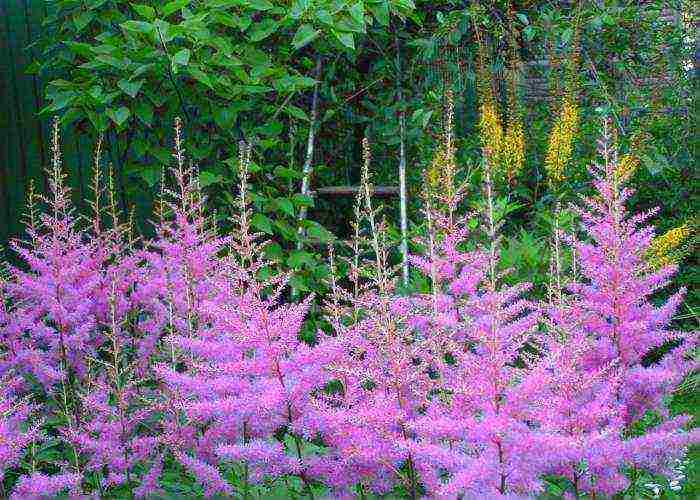
Early flowering variety. Medium leafy bush. The bush can be up to 1 meter high. The leaves are small, graceful, green-brown. Panicle-shaped inflorescences, up to 30 cm in length and up to 12 cm in diameter. The flowers are large, 5-6 cm in diameter, blue-violet in color. The scent of flowers is almost imperceptible. It begins to bloom early, blooms for a long time, up to 35 days. The variety is frost-resistant, loves shade and requires constant watering.
back to contents ↑ Arends
Hybrid variety breeder Arends. Summer flowering variety. Low-leafed bush. The bushes can be up to 160 cm high. The leaves are medium-sized, dark green in color, there are few of them on the bushes. Panicle inflorescences are tall, large and dense, up to 50 cm in length and 20 cm in diameter. The flowers are large, up to 8 cm in diameter, deep pink. The aroma is very subtle. The variety blooms throughout the summer. Doesn't like shadow. Poorly tolerates frost.
back to contents ↑ Visions in Red
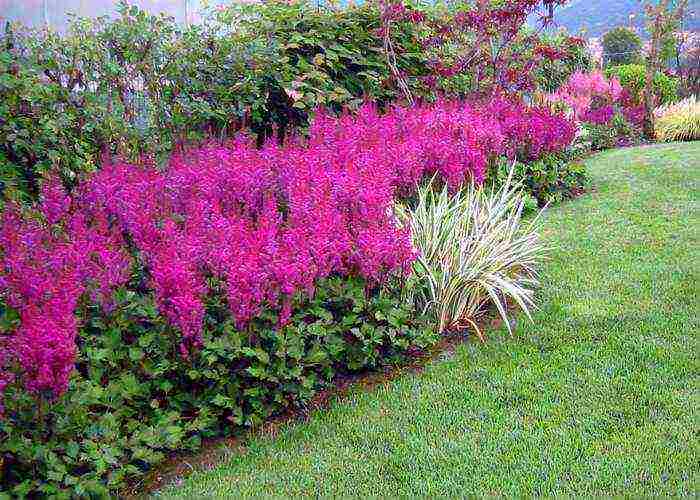
Late flowering variety of Chinese astilba. The bush is compact, low, up to 30 cm. The leaves are large, shiny, green, delicate and carved. Panicle inflorescences are dense, dense, small. The flowers are bright purple, small, with a heady strong aroma. The variety blooms from late August to late September, rarely, but can bloom longer. Frost-resistant variety, loves moisture and shade. Requires a transplant every 5 years.
Back to contents ↑ Gloria (white)
Medium flowering hybrid variety.The bush is medium-sized, the foliage is medium. The height of the bush can be 50-70 cm. The leaves are dark green with squirrel, carved openwork shape. Panicle inflorescences are lush, diamond-shaped, small, up to 15 cm in length, very fragile. The flowers are small, white in color and with a strong aroma. The variety loves partial shade and an abundance of moisture. Does not tolerate severe frosts.
back to contents ↑ Pomegranate (red)
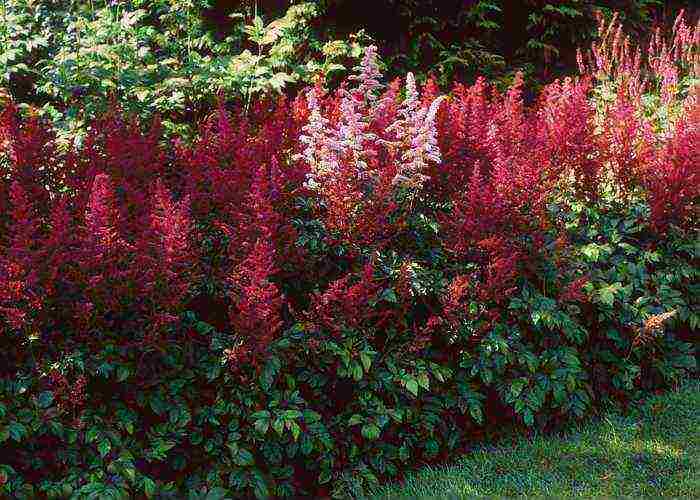
A perennial variety of flowers of simple garden astilba. Bushes of this variety can reach a height of 2 meters. The leaves are large, delicate, carved, green with a shimmer. Located in the root zone of the bush. Panicle inflorescences occupy approximately 70% of the entire height of the bush. The flowers are blood-red, large, up to 8 cm in diameter. Flowers have a honey aroma. The shrub begins to bloom in July, the duration of flowering is up to 40 days. Frost-resistant, light-loving and moisture-loving variety.
back to contents ↑ Diamond
A variety of white hybrid flowers bred by Arends. Bushes are wide, spreading, pyramidal, up to 70 cm in diameter and up to 1.5 m in height. The leaves are dark green, of medium size, there are few leaves on the bushes. Panicle inflorescences are high, dense, pyramidal, up to 50 cm in length. The flowers are large, up to 8 cm in diameter, white. The aroma is subtle. Long bloom, up to 40 days from mid-summer. The variety is well suited for the Moscow region and the surrounding regions.
back to contents ↑ Europe
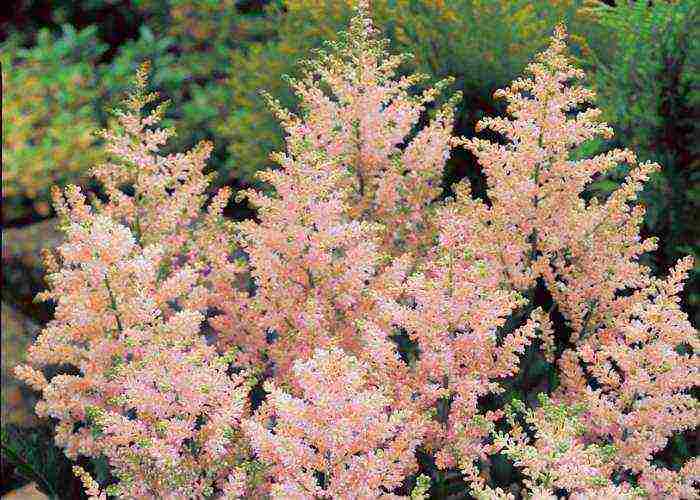
An early flowering variety of Japanese astilba. The bushes are low, spreading, up to 50 cm in height. The leaves are bright green, delicate, carved, located in the root zone of the bush and there are few of them. Inflorescences-panicles are pyramidal in shape, dense, densely covered with flowers, reaching 20 cm in length. The flowers are large, pale pink, delicate shade. Flowers have no scent. Duration of flowering up to 30 days from the end of May. The variety is frost-resistant. It is advisable to plant in the shade and not on loose soils. Requires a stable abundant watering.
back to contents ↑ Lavender
Early flowering variety. Sprawling bushes, up to 1 meter high. The leaves are dark green with shine, small and there are many of them. The leaves are located in the root zone of the shrub. Panicle inflorescences are not particularly lush, up to 25 cm in length. The flowers are small, lavender in color, there are few of them per inflorescence. The flowers emit a strong aroma with hints of honey. The duration of flowering shrub can be all summer, starting in mid-June. The variety is frost-resistant, grows well both in the sun and in the shade.
back to contents ↑ Montgomery
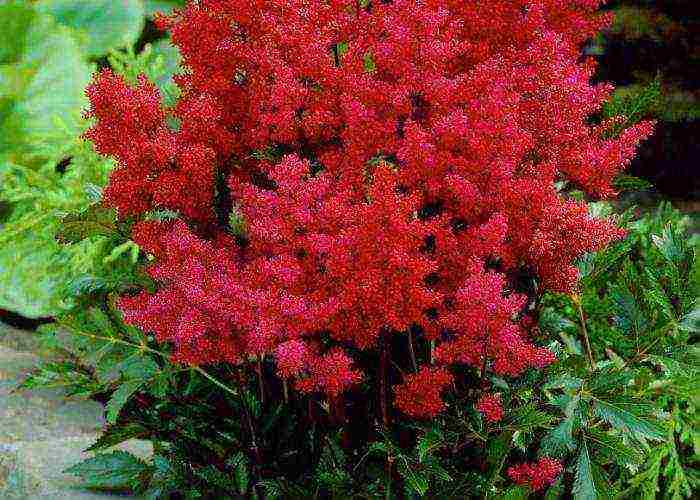
An early flowering variety of Japanese astilba. Sprawling bush, voluminous, up to 70 cm in height and 50 cm in volume. Leaves are medium-sized, shiny, green, divided, triple, few leaves on the bush. Lush panicle inflorescences, up to 17 cm in length. The flowers are large, rhombic, up to 10 cm in diameter. Flowers do not emit aroma. Flowering lasts 15-20 days in June. The variety is frost-resistant, loves moisture, does not like shade. Requires a transplant every 5 years.
Back to contents ↑ Nemo
Hybrid early flowering variety. A bush of medium height up to 75 cm, spreading, up to 50 cm wide. The leaves are large, dark green, located in the root zone. Panicle inflorescences are high, dense, up to 20 cm in length. The flowers are large, deep pink in color. Abundant flowering from June to July. The variety loves moisture, a warm, sunny place. Well tolerates winter. Resistant to most diseases.
back to contents ↑ Purple Rain (pink)
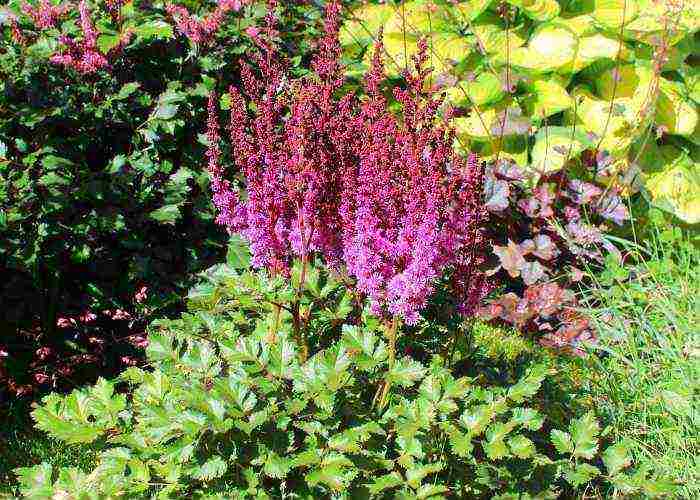
Hybrid variety of early flowering Chinese dwarf astilba. The bushes are small, compact, 40-50 cm in height. The leaves are small, shiny, light green. There are few leaves on the bushes. Panicle inflorescences are fragile, small, up to 12 cm in length. The flowers are small, purple-pink. The flowers give off a very bright honey scent. Long bloom, up to 40 days from the end of June. Unpretentious variety, does not require pruning, is not afraid of frost.
Back to contents ↑ Red Sentinel
Medium flowering red flower variety. The bush is low, wide, spreading, up to 70 cm in height. There are few leaves on the bushes.The leaves are large, dark green, carved, located in the root zone of the shrub. The main inflorescence is a panicle, 30-40 cm long, dense. The flowers are small, red in color, collected in small panicle pyramidal inflorescences. Flowering lasts up to 30 days from the end of July. The plant is frost-resistant, light-requiring. The variety can grow up to 10 years in one place without transplanting.
back to contents ↑ Pink ostrich feather

A variety of tall flowers astilba of late flowering. The bush is high, spreading, up to 1 meter in height. The leaves are large, carved, emerald green. Inflorescence up to 40 cm long, drooping, looks like an ostrich feather. The flowers are small, fluffy, pale pink. The flowering period is long, from late August to mid-autumn. The variety requires a sunny place and abundant watering. Frost resistant.
Back to contents ↑ Sister Teresa
Hybrid variety breeder Arends. The bush is tall, practically without leaves. Outwardly, the bush resembles a fluffy ball. The bush is up to 80 cm high. The leaves are large, located in the root zone of the bush, carved, dark green and with a burgundy tint, shiny. Panicle inflorescences are up to 40 cm long. The flowers are small, collected in lush small peach-colored inflorescences. The flowers emit a sugary aroma. The flowering period of the variety is up to 20 days from the end of July. The variety does not tolerate shade and does not tolerate severe frosts.
back to contents ↑ Thunberg
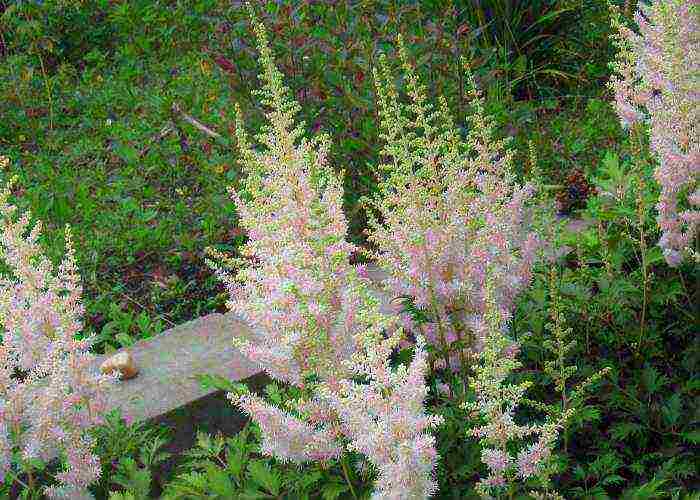
Late flowering variety of Japanese astilba. Bush up to 1 meter high. The leaves are green-yellow with a brown stem, separated, openwork. There are few leaves on the bushes. Panicle inflorescence up to 50 cm long. The flowers are small, fluffy, white-pink, with a honey aroma. The flowering period is about a month from the end of August. Frost-resistant, shade-loving and moisture-loving variety.
Back to contents ↑ Henny Grafland
Late flowering variety. The bush is of medium height up to 70 cm. The leaves are carved, small, delicate, light green. There are many leaves and they are located in the root zone of the bush. Panicle inflorescence up to 40 cm long, thin and fragile. The flowers are pale pink, fluffy, small, in paniculate inflorescences. The flowering period is up to 40 days from the beginning of September. The variety tolerates shady terrain and frosts well. Loves moisture. Requires an annual transplant.
Back to contents ↑ Unique Carmine

Hybrid dwarf cultivar of astilba flowers of medium flowering period. The bushes are small, but wide, up to 40 cm in diameter and up to 45 cm in length. The leaves are large, there are many of them on the bushes, dark green in color. Panicle inflorescences are lush, dense. The flowers are small, fluffy, red-pink in color. Long and abundant flowering. The variety blooms from late July to 2 months. The variety is frost-resistant. Grows in full sun, shade and partial shade, but with constant watering.
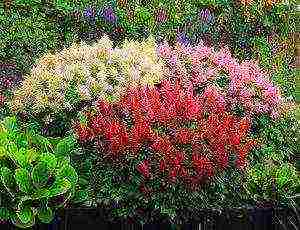 Astilba is an unpretentious, but rather spectacular plant that has gained wide popularity among gardeners. Thanks to the original inflorescences and fairly decorative leaves, this perennial can become a real decoration of the garden plot. Bush plant from 20 to 200 cm in height (depending on the variety). Has paniculate inflorescences from 8 to 60 cm, white, pink, red, purple and all shades intermediate between these colors. Blooms from June to September. After flowering, forms a seed capsule. More about growing astilba HERE.
Astilba is an unpretentious, but rather spectacular plant that has gained wide popularity among gardeners. Thanks to the original inflorescences and fairly decorative leaves, this perennial can become a real decoration of the garden plot. Bush plant from 20 to 200 cm in height (depending on the variety). Has paniculate inflorescences from 8 to 60 cm, white, pink, red, purple and all shades intermediate between these colors. Blooms from June to September. After flowering, forms a seed capsule. More about growing astilba HERE.
Types of astilba
The cultivated plant "Astilba" has more than 200 varieties. Below are the 3 main classifications of astilbe species. It should be noted that the first 2 classifications are consumer, and the third is scientific.
Astilba classification depending on the height of the bush:
✿ Dwarf - up to 30 cm in height
✿ Undersized - from 30 to 60 cm
✿ Medium height - from 60 to 90 cm
✿ Tall - more than 90 cm
Classification of astilba by the shape of the inflorescences:
✿ Pyramidal. The lateral branches of each inflorescence grow at an almost 90 degree angle from the main axis. They tend to decrease evenly as they grow towards the top.
✿ Rhombic. The name comes from the shape of the leaves, which looks like a diamond.Each of the inflorescences grows at an acute angle from the base. In most cases, this includes the "Japanese" varieties of Astilba.
✿ Paniculata. Flowers of this species grow at an acute angle, only they have a fairly large number of branches. Most often these include Arends varieties.
✿ Drooping. The inflorescence stem is flexible and arched. They are also called "drooping" inflorescences. These include the Tenberg and Lemoine varieties.
Astilba classification by hybridization:
✿ Arends hybrids. Used for planting in groups.
✿ Astilba hybrids. This subgroup combines more than 50 varieties.
✿ Japanese hybrids. Low plants, more often used for group plantings.
✿ Lemoine hybrids. There are about 20 species.
✿ Thunberg hybrids. Includes plants with drooping flowers.
Popular varieties of astilba,
cultivated in Russia
ASTILBA RENT
Astilba of this species has about forty varieties and bears the name of the breeder G. Arends, who bred the variety. These astilbe bushes grow up to 1.5 meters in height, have dark green leaves with a burgundy border. Inflorescences are of two types: circular and cone-shaped. Differs in long flowering and high peduncles from white to dark burgundy. Popular varieties of this type of astilba are listed below.
Amethyst
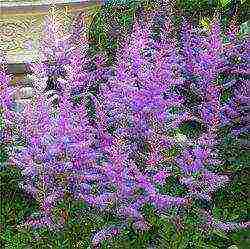 The medium-sized variety reaches up to a meter in height, has light green leaves and strong stems with delicate lilac inflorescences. It is beautiful both as a single plant, and in mixed plantings, in flower beds and in flower beds.
The medium-sized variety reaches up to a meter in height, has light green leaves and strong stems with delicate lilac inflorescences. It is beautiful both as a single plant, and in mixed plantings, in flower beds and in flower beds.
Gloria
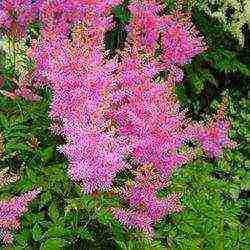 A lush bush with juicy green leaves, it grows about a meter in height, blooms with diamond-shaped inflorescences of a pale pink hue.
A lush bush with juicy green leaves, it grows about a meter in height, blooms with diamond-shaped inflorescences of a pale pink hue.
Glut
 The leaves of this Ardens hybrid are juicy dark green with a brown tint. Grows up to 90 cm in height. Paniculate inflorescences are presented in all tones of red: from carmine to bright scarlet. Flowering lasts about 20-22 days.
The leaves of this Ardens hybrid are juicy dark green with a brown tint. Grows up to 90 cm in height. Paniculate inflorescences are presented in all tones of red: from carmine to bright scarlet. Flowering lasts about 20-22 days.
Hyacinth
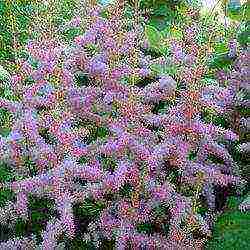 Fluffy light lilac inflorescences of hyacinth at the beginning of flowering resemble a Christmas tree. The main color of the leaves is juicy green, the edges are brownish. It grows up to a meter in height, blooms for 14 days.
Fluffy light lilac inflorescences of hyacinth at the beginning of flowering resemble a Christmas tree. The main color of the leaves is juicy green, the edges are brownish. It grows up to a meter in height, blooms for 14 days.
Diamond
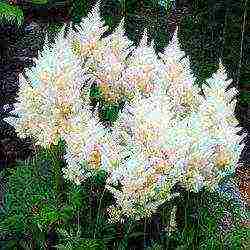 This astilbe is dazzlingly white, which makes it especially stand out against the green background of the leaves. The diamond blooms for about a month and will make an indelible impression on a green lawn among evergreen conifers.
This astilbe is dazzlingly white, which makes it especially stand out against the green background of the leaves. The diamond blooms for about a month and will make an indelible impression on a green lawn among evergreen conifers.
Ruby
 Ruby grows up to 80 cm in height. It has strong, branched stems with green, tapering leaves. Inflorescences are lilac, pale in color, paniculate in shape. This variety is combined with brighter flowers and is suitable as a frame for a flower bed.
Ruby grows up to 80 cm in height. It has strong, branched stems with green, tapering leaves. Inflorescences are lilac, pale in color, paniculate in shape. This variety is combined with brighter flowers and is suitable as a frame for a flower bed.
Erika
 This spectacular variety has an unusual color of stems and leaves: the stems are burgundy, and the leaves are brown-red. Carmine inflorescences are no less beautiful. This variety can be used to decorate any corner of the garden.
This spectacular variety has an unusual color of stems and leaves: the stems are burgundy, and the leaves are brown-red. Carmine inflorescences are no less beautiful. This variety can be used to decorate any corner of the garden.
ASTILBA DAVID
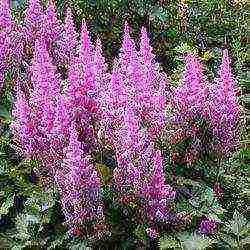 This tall astilbe has been known to gardeners since 1902. It is a perennial spreading shrub with thin burgundy stems. Green leaves are like feathery compositions. The leaf blades seem to be shriveled, the petioles and veins on them are brown. Astilba David grows up to 1.5 meters in height. The inflorescences are not too lush, which is offset by a bright pink color. The inflorescences have the shape of an elongated pyramid with a light fluff along the axis. The plant blooms in late July - early August, blooms for two weeks. At the end of flowering, seed pods are formed.
This tall astilbe has been known to gardeners since 1902. It is a perennial spreading shrub with thin burgundy stems. Green leaves are like feathery compositions. The leaf blades seem to be shriveled, the petioles and veins on them are brown. Astilba David grows up to 1.5 meters in height. The inflorescences are not too lush, which is offset by a bright pink color. The inflorescences have the shape of an elongated pyramid with a light fluff along the axis. The plant blooms in late July - early August, blooms for two weeks. At the end of flowering, seed pods are formed.
ASTILBA NAKED
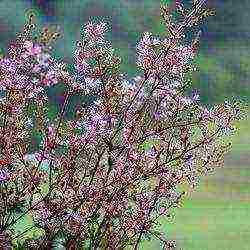 A small shrub blooming with pale pink small flowers in late June - early July. Many gardeners admire the dwarf bare astilba of the Saxatilis variety, which grows only up to 12 cm, and the diameter of the bush is no more than 15 cm. In the sun, its leaves are cast in bronze.
A small shrub blooming with pale pink small flowers in late June - early July. Many gardeners admire the dwarf bare astilba of the Saxatilis variety, which grows only up to 12 cm, and the diameter of the bush is no more than 15 cm. In the sun, its leaves are cast in bronze.
ASTILBA CHINESE
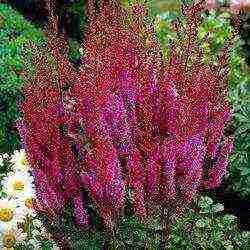 This species is quite tall (up to 110 cm), does not need special care, is completely unpretentious and frost-resistant. Gardeners especially appreciate and love it for its long flowering and bright various colors.Most hybrids of Chinese Astilba have dark red stems, patterned foliage, pubescent with a pile, and paniculate inflorescences. Inflorescences are presented in shades of pink, lilac, red, white ones are found. Chinese Astilba is an aggressor: over time, its root system grows and crowds out its neighbors.
This species is quite tall (up to 110 cm), does not need special care, is completely unpretentious and frost-resistant. Gardeners especially appreciate and love it for its long flowering and bright various colors.Most hybrids of Chinese Astilba have dark red stems, patterned foliage, pubescent with a pile, and paniculate inflorescences. Inflorescences are presented in shades of pink, lilac, red, white ones are found. Chinese Astilba is an aggressor: over time, its root system grows and crowds out its neighbors.
The brightest varieties: ✿ "Vision in Red" - red with purple
✿ "Vision in Pink" - pale pink flowers
✿ "Purpurlanz" - purple hue inflorescences.
ASTILBA PLAIN
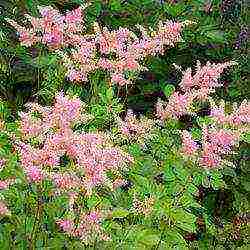 This plant has drooping inflorescences, whole juicy green and glossy leaves. Differs in the most lush panicles of white, cream and yellow inflorescences. Especially hardy compared to other varieties.
This plant has drooping inflorescences, whole juicy green and glossy leaves. Differs in the most lush panicles of white, cream and yellow inflorescences. Especially hardy compared to other varieties.
The most popular varieties: ✿ "Bronze Elegance" - pink with a bronze sheen
✿ "Straussenfeeder" - flowers of a coral shade
✿ "Preacox Alba" - inflorescences with white racemes
ASTILBA TUNBERGA
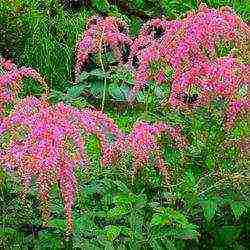 A perennial shrub grows up to 80 cm in height. Its distinctive feature is glossy oval leaves with brown edges. Inflorescences in Thunberg hybrids are long - up to 25 cm, in the form of a drooping brush.
A perennial shrub grows up to 80 cm in height. Its distinctive feature is glossy oval leaves with brown edges. Inflorescences in Thunberg hybrids are long - up to 25 cm, in the form of a drooping brush.
Two varieties take root in the Urals: ✿ "Professor van der Wilen" bush height up to 1 m, white inflorescences
✿ "Straussnfeder" - has pink brushes
ASTILBA JAPANESE
Japanese hybrids have different heights - from 40 cm to 1 meter. The lacy leaves range in color from light green to reddish-brown tones. Lush inflorescences come in a wide variety of shades. These plants are beautiful in single plantings, and the brightest of them can be the center of the composition. Popular varieties of this type of astilba are listed below.
Bremen
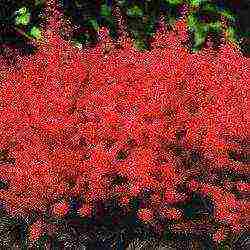 Low grade, does not grow up to half a meter. The leaves are openwork, light green in color. Inflorescences are large, up to 15 cm, crimson.
Low grade, does not grow up to half a meter. The leaves are openwork, light green in color. Inflorescences are large, up to 15 cm, crimson.
Gladstone
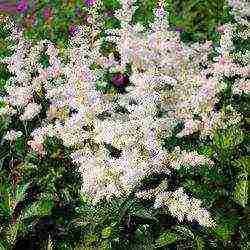 Half-meter neat bushes with white inflorescences, reminiscent of the snow-covered tops of Christmas trees.
Half-meter neat bushes with white inflorescences, reminiscent of the snow-covered tops of Christmas trees.
King Alfred
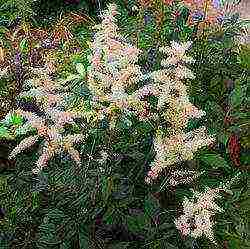 The bush, with proper care, grows up to 70 cm. Delicate white inflorescences look organically against a green background of foliage.
The bush, with proper care, grows up to 70 cm. Delicate white inflorescences look organically against a green background of foliage.
Peach Blossom
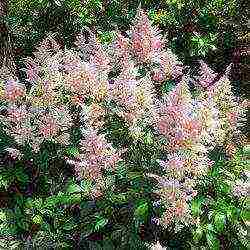 Compact bush, 60 cm high. The leaves are bright green in the center, bordered with a brown stripe along the edge. The inflorescences are small, pale pink, but they do not bloom for long - up to 12 days.
Compact bush, 60 cm high. The leaves are bright green in the center, bordered with a brown stripe along the edge. The inflorescences are small, pale pink, but they do not bloom for long - up to 12 days.
Plume
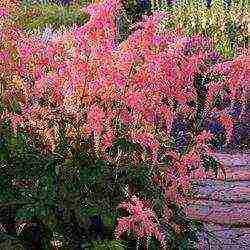 The height of the bush is up to 80 cm. The inflorescences are dense, creamy white or light pink shades.
The height of the bush is up to 80 cm. The inflorescences are dense, creamy white or light pink shades.
Montgomery
 This astilba resembles a juicy pomegranate in its color. Large bright inflorescences bloom in late summer. The leaves are brownish, diamond-shaped. The bush grows up to 70 cm.
This astilba resembles a juicy pomegranate in its color. Large bright inflorescences bloom in late summer. The leaves are brownish, diamond-shaped. The bush grows up to 70 cm.
Where to Buy Astilba Seeds
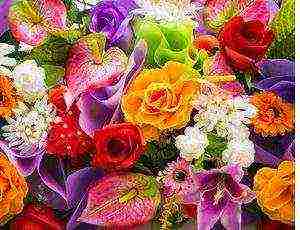 The Scientific and Production Association "Sady Rossii" has been introducing the latest achievements in the selection of vegetable, fruit, berry and ornamental crops into the wide practice of amateur gardening for 30 years. In the work of the association, the most modern technologies are used, a unique laboratory for microclonal reproduction of plants has been created. The main tasks of NPO Sady Rossii is to provide gardeners with high-quality planting material for popular varieties of various garden plants and novelties of world selection. Delivery of planting material (seeds, onions, seedlings) is carried out by Russian post. We are waiting for you for shopping: NPO "Sady Rossii"
The Scientific and Production Association "Sady Rossii" has been introducing the latest achievements in the selection of vegetable, fruit, berry and ornamental crops into the wide practice of amateur gardening for 30 years. In the work of the association, the most modern technologies are used, a unique laboratory for microclonal reproduction of plants has been created. The main tasks of NPO Sady Rossii is to provide gardeners with high-quality planting material for popular varieties of various garden plants and novelties of world selection. Delivery of planting material (seeds, onions, seedlings) is carried out by Russian post. We are waiting for you for shopping: NPO "Sady Rossii"
In order to grow the most decorative and abundantly flowering plant, it is necessary to fulfill a number of simple conditions. Plant in loose and organic-rich loamy or sandy loam garden soil with the addition of complex mineral fertilizer, annually in spring or late autumn, mulch abundantly already matured astilbe bushes with well-rotted manure, compost or peat and do not forget to feed perennial fertilizers 3-4 times during the season for beautiful ...
For maximum decorativeness, it is enough to follow simple care rules. Opal variety From my experience, I would like to add that the abundance of annual flowering also depends on the timely removal of faded stems. Astilba belongs to perennials in which each renewal shoot goes through a two-year development cycle.In the first year of the growing season, replacement buds develop only a rosette of leaves that appears after the mother shoot fades, on the lower part of which they sit. And only the next year a peduncle should develop from the apical bud located inside the outlet.
Astilba will bloom more abundantly if the fading stems are removed in time. Variety Gloria The development and emergence of young rosettes is inhibited if the fading stems spend time and energy on setting seeds, which, however, rarely ripen in Astilba in the Moscow region. On the contrary, the timely removal of the fading arrows stimulates the establishment of full-fledged flower buds in the developing new rosettes, which, growing, also transform the bushes of plants in a pleasant way until late autumn. Therefore, as soon as the panicles of astilba begin to turn brown and lose their decorative effect, feel free to remove them, giving the plant a long-awaited rest after the festive fireworks of flowering.
The modern abundance of magnificent varieties expands the range of applications of Astilba, and it will decorate any flower garden in the garden with dignity. For example, miniature and dwarf varieties sporting funny little panicles like inflorescences such as
'Perkeo' ,
‘Dagalet’ ,
‘Liliput’ ,
‘Peter Pan’ ,
'Sprite' ,
‘Pumila’ in addition, with its filigree cut leathery foliage, the nobility of picturesque patterned or old mossy stones in rockeries is emphasized.

Miniature astilbe Lilliput will look great in rockeries And the borders of compactly growing varieties of astilbe from the Arends (A.arendsii), Japanese (A. japonica), simple-leaved (A. simplicifolia) and Thunberg (A. thunbergii) groups are not decorative in regular-style flower beds only during flowering. Until late autumn, the bushes with graceful pinnately dissected leaves ideally keep the appropriate strict shape and never fall apart.

Astilbe in the flower garden In the flower beds and mixborders, astilbe are excellent partners for daylilies, phlox, host, geyher, tradescantia, brunner and many other popular horticultural crops. In flower beds, astilba can be a solo plant, or it can successfully play the role of a secondary element or background for other flowers of a ceremonial flower garden, while not at all losing its majestic expressiveness.
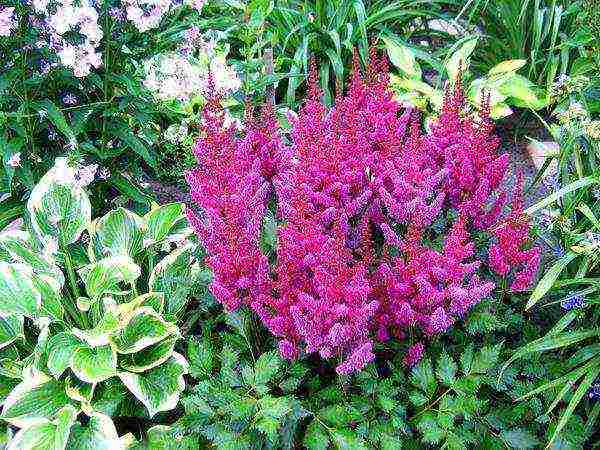
Astilbe is an excellent partner for many horticultural crops. Variety Visions in Red In group landscape compositions, Astilbe varieties with flaming colors - such as ‘Fanal’, ‘Etna’, 'Glut', ‘Spinell’, ‘Montgomery’, 'Red Sentinel' can serve as a bright accent and, like a flared bonfire, attract admiring glances.

Bright Montgomery - like a flaring fire 'Straussenfeder', ‘Avalanche’, 'Brautschleier', ‘Prof. Van der Wielen ', ‘Moerheimii’, 'Flamingo', ‘Pink Lighting’ with the most delicate gracefully drooping inflorescences, they will add romance and lightness to flower gardens, creating the illusion of a waterfall turning pink at sunset, or winter tree branches covered with heavy snow.

The graceful Straussenfeder for a romantic flower garden ‘Amethyst’, ‘Bremen’, 'Gloria', 'Finale', 'Lollipop', ‘Catleya’, 'Snowdrift', ‘Superba’, 'Purpurkerze', ‘Visions’ and many other wonderful varieties.
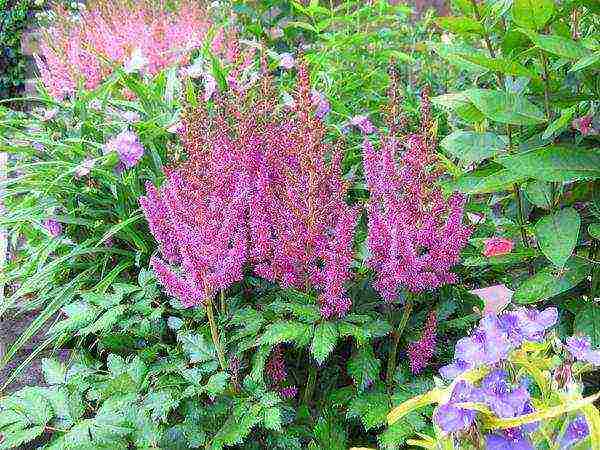
Spectacular Visions will be appropriate in any flower garden.They can, depending on their characteristics, quickly grow in vast meadows, drowning out annoying weeds, or compactly and unobtrusively coexist with other flowers for many years, taking up only the allotted space for them. And, of course, astilbes are traditionally grown in shady flower beds, where they illuminate the secluded corners of the garden with colorful fireworks of fluffy inflorescences, and by the reservoir, where astilbes will bring an element of peace of mind, bizarrely reflected in the dark water.


